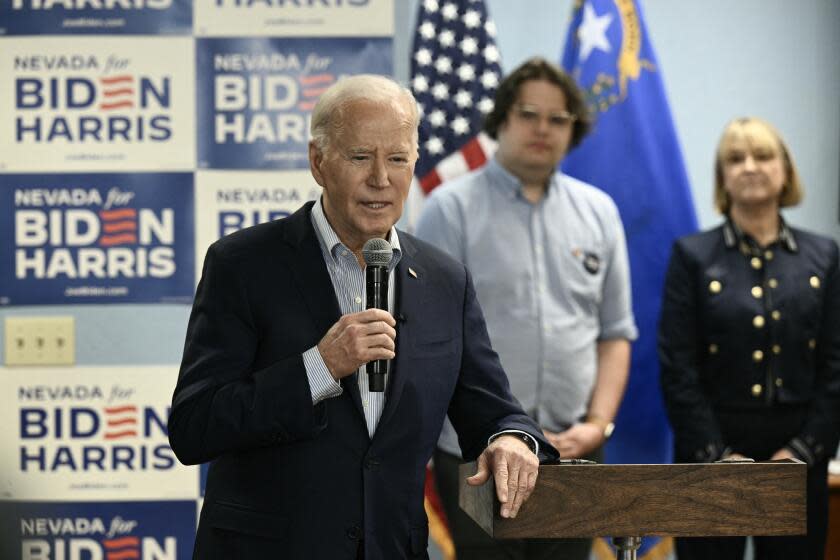Biden touts high-speed rail between Southern California and Las Vegas

- Oops!Something went wrong.Please try again later.
President Biden touted a high-speed rail project that will connect Las Vegas with Southern California, funded by billions of federal dollars, as he campaigned in Nevada on Tuesday.
“Guess what? It's coming,” he told supporters at a campaign event in Reno. “Well over a billion dollars, man. And you're going to be able to get to — not that anybody wants to get to Los Angeles, but people from Los Angeles want to get to Nevada. Well, they’ll do it in two hours instead of four and take tens of thousands of vehicles off the road and improve the environment.”
The planned rail line actually ends in Rancho Cucamonga, in San Bernardino County, about 40 miles east of Los Angeles.
Read more: New high-speed train from Vegas to SoCal will be a model for the nation — if it succeeds
Biden made the remarks at the start of a two-day visit to Western swing states that is largely focused on Latino voters and pocketbook issues, such as the cost of insulin, housing affordability, job creation and taxes.
His campaign announced a new ad focused on Latino voters — produced in English, Spanglish and Spanish — as well as the launch of Latinos con Biden-Harris, an effort to mobilize Latino voters when there has been concern about softening support among Latinos for the Democratic ticket.
Nevada and Arizona, where Biden is spending Tuesday and Wednesday, are critical for his reelection prospects. And the issues that are front-of-mind in these states, such as immigration, the economy, election denialism and abortion rights, are driving forces in the presidential contest between Biden and former President Trump.
Read more: Arizona and Nevada make up 3% of the U.S. population — and are vital to picking a president
On Tuesday, at events in Reno and Las Vegas, Biden twice mentioned the $12-billion, 218-mile route between Las Vegas and Rancho Cucamonga that the private company Brightline hopes to open by 2028. With speeds of up to 200 mph, it would be the first true high-speed rail line in the United States.
The federal government is spending $3 billion on the project, as well as offering access to $3.5 billion in tax-exempt bonds.
The Biden administration is also spending more than $3 billion on the public high-speed rail project that is supposed to link San Francisco with Los Angeles, but that line has faced many more logistical and political hurdles and much more skepticism from experts.
Biden, noting that the Vegas-Rancho Cucamonga line is expected to create 35,000 jobs, said at an official White House appearance in Las Vegas that he hoped that the project would "encourage" the creation of the high-speed rail line through the Central Valley.
"The idea that we haven't had one single high-speed rail built in America up to now is ridiculous," Biden said.
Republicans said the Biden administration’s policies have been disastrous for Nevadans.
“Nevada families are being crushed by Joe Biden’s failures, from historic inflation and an open border to skyrocketing overdose deaths across the state,” Michael Whatley, chair of the Republican National Committee, said in a statement. “Nevadans want results, not lip service — which is why they’ll vote to elect President Donald J. Trump in November."
Times staff writer Noah Bierman in Washington, D.C., contributed to this report.
This story originally appeared in Los Angeles Times.

